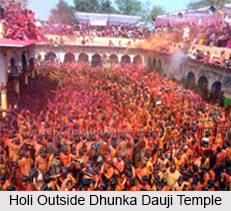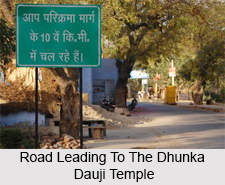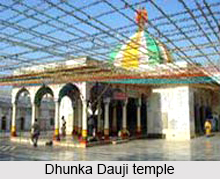 Dhunka Dauji or Luk-luk Dauji (means `spying` or `peeping` Dauji) is an open air shrine. This shrine is situated on the top of the hill, south of Jatipura village, above the parikrama road. A large kitchen is situated on the opposite side of the road, which is used by local Vallabhites. They cook a huge amount of food necessary for the so called `chappan-bhog` (means `the fifty-six dishes`) or culinary preparations essential for the festival here.
Dhunka Dauji or Luk-luk Dauji (means `spying` or `peeping` Dauji) is an open air shrine. This shrine is situated on the top of the hill, south of Jatipura village, above the parikrama road. A large kitchen is situated on the opposite side of the road, which is used by local Vallabhites. They cook a huge amount of food necessary for the so called `chappan-bhog` (means `the fifty-six dishes`) or culinary preparations essential for the festival here.
Braj Yatra at Dhunka Dauji
One of the highlights of the autumnal pilgrimage (Braj yatra) is said to be this festival. A large pandal is prepared down the hill slope under which various kinds of food are displayed. It is said that in the meantime, the deity, Dhunka Dauji himself starts peeping from his den above the hill. He eagerly tries to get a view of the food displayed below, the view to which he is actually denied access. It is said that in this area most of the Buddhist icons were found. This part was later inhabited by some Gaudiya Vaishnavas, followers of Chaitanya. These people even today worship the hill as divine and do not set foot on it. It is said that in hands of the Vallabhite priests, the presiding deity within the pandal takes the form of Shri Nathji (i.e. Sri Govardhannathji), the Lord of the Govardhan Hill. This deity is dressed like the Jatipura Mukharvind and he is fitted with a raised `Ann`, made of black stuffed cotton, on his left side, while his right hand rests on his waist, as in all proper Shri Nathji icons throughout Braj.
It is said that in hands of the Vallabhite priests, the presiding deity within the pandal takes the form of Shri Nathji (i.e. Sri Govardhannathji), the Lord of the Govardhan Hill. This deity is dressed like the Jatipura Mukharvind and he is fitted with a raised `Ann`, made of black stuffed cotton, on his left side, while his right hand rests on his waist, as in all proper Shri Nathji icons throughout Braj.
Bhog at at Dhunka Dauji
The chappan bhog displayed till then in front of deity is maintained. The chappan bhog displayed in front of the Dhunka Dauji shrine includes only pakka (cooked) foods which represent god Baldev`s regular diet. The Vallabhite priests change the deity, but not the food ritual. Baldev is famous for being the birthplace of Lord Balarama. Lord Balarama was the elder brother of Lord Krishna and the 8th incarnation of Lord Vishnu. The sacrosanct Holi is played in the premises of Dauji temple. 
The Dhunka Dauji shrine itself is a curiously crushed rock, which has a depression in the middle. It is surrounded by large Govardhan stones, which stands in a row over the depression and all of them smeared with sindur (red-lead power). The highest stone, which stands in the middle, is interpreted as a `swayamhhu` (self-make) `Shivalinga` or as a manifestation of god Dauji himself. There are other stones around this, which probably represent associated folk deities.



















